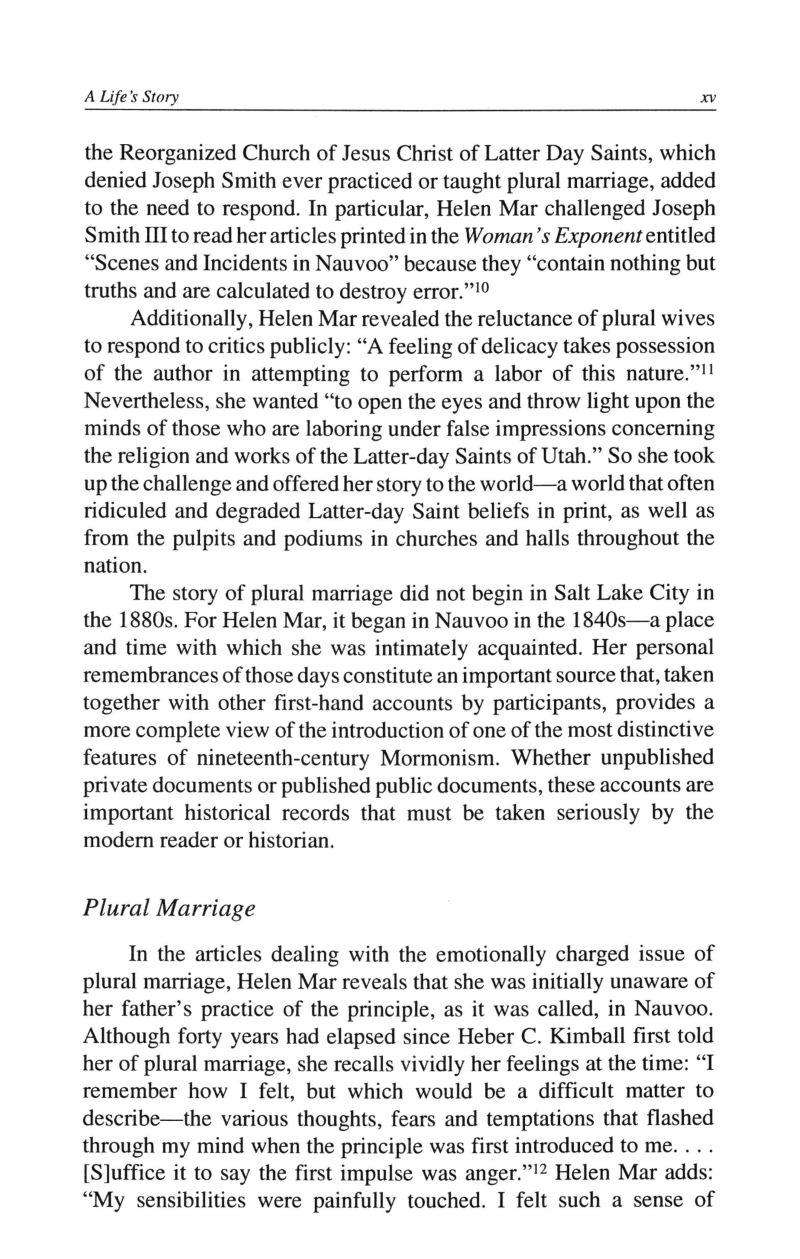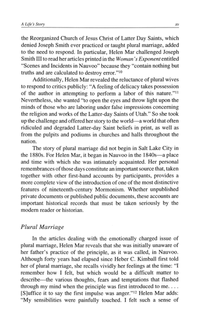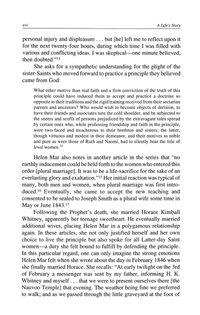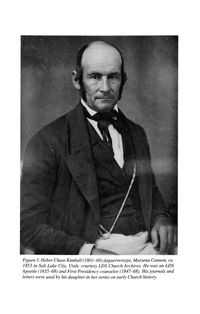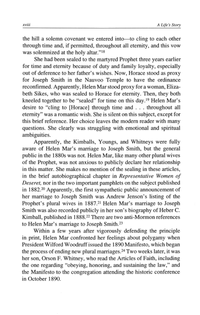Jeni Broberg Holzapfel and Richard Neitzel Holzapfel introduce Helen Mar Kimball's writings; briefly discuss her marriage to Joseph.
- Type
- Book
- Source
- Jeni Broberg Holzapfel LDS
- Hearsay
- Secondary
- Reference
A Woman’s View: Helen Mar Whitney’s Reminiscences of Early Church History, ed. Jeni Broberg Holzapfel and Richard Neitzel Holzapfel (Provo, Utah: Religious Studies Center, Brigham Young University, 1997), xv–xviii
- Scribe/Publisher
- BYU Religious Studies Center
- People
- Jeni Broberg Holzapfel, Richard Neitzel Holzapfel
- Audience
- Reading Public
- Transcription
Plural Marriage
In the articles dealing with the emotionally charged issue of plural marriage, Helen Mar reveals that she was initially unaware of her father’s practice of the principle, as it was called, in Nauvoo. Although forty years had elapsed since Heber C. Kimball first told her of plural marriage, she recalls vividly her feelings at the time: “I remember how I felt, but which would be a difficult matter to describe—the various thoughts, fears and temptations that flashed through my mind when the principle was first introduced to me. . . . [S]uffice it to say the first impulse was anger.” Helen Mar adds: “My sensibilities were painfully touched. I felt such a sense of personal injury and displeasure .. . but [he] left me to reflect upon it for the next twenty-four hours, during which time I was filled with various and conflicting ideas. I was skeptical—one minute believed, then doubted.”
She asks for a sympathetic understanding for the plight of the sister-Saints who moved forward to practice a principle they believed came from God:
What other motive than real faith and a firm conviction of the truth of this principle could have induced them to accept and practice a doctrine so opposite to their traditions and the rigid training received from their sectarian parents and ancestors? Who would wish to become objects of derision, to have their friends and associates turn the cold shoulder, and be subjected to the sneers and scoffs of persons prejudiced by the extravagant tales spread by certain ones who, while professing friendship and faith in the principle, were two-faced and treacherous to their brethren and sisters; the latter, though virtuous and modest in their demeanor, and their motives as noble and pure as were those of Ruth and Naomi, had to silently bear the title of lewd women.
Helen Mar also notes in another article in the series that “no earthly inducement could be held forth to the women who entered this order [plural marriage]. It was to be a life-sacrifice for the sake of an everlasting glory and exaltation.” Her initial reaction was typical of many, both men and women, when plural marriage was first introduced. Eventually, she came to accept the new teaching and consented to be sealed to Joseph Smith as a plural wife some time in May or June 1843.
Following the Prophet’s death, she married Horace Kimball Whitney, apparently her teenage sweetheart. He eventually married additional wives, placing Helen Mar in a polygamous relationship again. In these articles, she not only justified herself and her own choice to live the principle but also spoke for all Latter-day Saint women—a duty she felt bound to fulfill by defending the principle. In this particular regard, one can only imagine the strong emotions Helen Mar felt when she wrote about the day in February 1846 when she finally married Horace. She recalls: “At early twilight on the 3rd of February a messenger was sent by my father, informing H. K. Whitney and myself. . . that we were to present ourselves there [the Nauvoo Temple] that evening. The weather being fine we preferred to walk; and as we passed through the little graveyard at the foot of the hill a solemn covenant we entered into—to cling to each other through time and, if permitted, throughout all eternity, and this vow was solemnized at the holy altar.”
She had been sealed to the martyred Prophet three years earlier for time and eternity because of duty and family loyalty, especially out of deference to her father’s wishes. Now, Horace stood as proxy for Joseph Smith in the Nauvoo Temple to have the ordinance reconfirmed. Apparently, Helen Mar stood proxy for a woman, Elizabeth Sikes, who was sealed to Horace for eternity. Then, they both kneeled together to be “sealed” for time on this day. Helen Mar’s desire to “cling to [Horace] through time and . . . throughout all eternity” was a romantic wish. She is silent on this subject, except for this brief reference. Her choice leaves the modern reader with many questions. She clearly was struggling with emotional and spiritual ambiguities.
Apparently, the Kimballs, Youngs, and Whitneys were fully aware of Helen Mar’s marriage to Joseph Smith, but the general public in the 1880s was not. Helen Mar, like many other plural wives of the Prophet, was not anxious to publicly declare her relationship in this matter. She makes no mention of the sealing in these articles, in the brief autobiographical chapter in Representative Women of Deseret, nor in the two important pamphlets on the subject published in 1882. Apparently, the first sympathetic public announcement of her marriage to Joseph Smith was Andrew Jenson’s listing of the Prophet’s plural wives in 1887. Helen Mar’s marriage to Joseph Smith was also recorded publicly in her son’s biography of Heber C. Kimball, published in 1888. There are two anti-Mormon references to Helen Mar’s marriage to Joseph Smith.
Within a few years after vigorously defending the principle in print, Helen Mar confronted her feelings about polygamy when President Wilford Woodruff issued the 1890 Manifesto, which began the process of ending new plural marriages. Two weeks later, it was her son, Orson F. Whitney, who read the Articles of Faith, including the one regarding “obeying, honoring, and sustaining the law,” and the Manifesto to the congregation attending the historic conference in October 1890.
- Citations in Mormonr Qnas
The B. H. Roberts Foundation is not owned by, operated by, or affiliated with the Church of Jesus Christ of Latter-day Saints.

